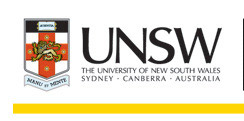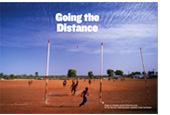Turning Japanese: the future of the Australian Japanese economic partnership.
Tim Harcourt*
When thinking of Australia’s future in the Asian Century, most minds turn to China, perhaps India, ASEAN and the rest of emerging Asia.
But it’s really Japan that Australia should thank for enabling us to get a foothold into the East Asian region in the first place. In fact, we were talking about ‘Abe- nomics’ over 50 years ago in 1957 when Trade Minister Abe (the current Prime Minister’s grandfather) signed the Commerce Agreement with John ‘Black-Jack” McEwen, Australia’s Country Party Deputy Prime Minister and Trade Minister. (in those days the Country Party now National Party always took the trade portfolio and Black Jack McEwen was followed by National Party icons like Doug Anthony, Tim Fischer in the trade portfolio in a tradition that was only ended a few weeks ago when the new Prime Minister Tony Abbott took trade off the Nats and gave it to Liberal Andrew Robb).
The 1957 agreement with Japan was of historical significance as it enabled Australia to finally embrace its geography and take commercial advantage of the industrial giant that Japan later became. Back in 1957, with the memory of the Pacific war still in everyone’s mind, and with cold war tensions afoot, it took great courage to negotiate the deal, and as it turned out, great foresight given Japan’s subsequent economic development. Japan played a crucial role in developing Australia’s export potential and gave us the confidence to embrace the region further with the Asian Tigers, ASEAN and now the emerging giants of China and India. In many ways, it was Japan who allowed us to break free from the ‘tyranny of distance’ mentality to embrace our geographical position in the world. Thanks to Japan – and our trade officials’ initiative to forge the agreement in 1957 – the tyranny of distance has been replaced by the ‘power of proximity’. Thanks to the rise of Japan and the rest of Asia, and our own efforts, Australia now finds it self in the right place at the right time.
But that’s the history, what about the future? There no doubt that China is replacing Japan as the main driver of Australia resource export development – playing a similar role now that Japan played in the 1960s and 1970s – and there are also signs that AEAN and India – despite recent troubles – is on the march as well. But given all the success we’ve had with Japan in the past, what more can be done in the future?
How can Australia and Japan widen and deepen its economic relationship over the next 20, 30 or 50 years?
I think future of this overall happy economic partnership will depend on the seven ‘F’s of Australian-Japan economic relations.
The first F is the Free Trade Agreement currently being negotiated with Tokyo. There’s plenty on offer, particularly in agriculture and services. Australia is seeking cuts in tariffs and non-tariff barriers and more openness in Japan’s previously closed rural and services markets whilst Japan is seeking energy security – particularly in LNG. Both nations are seeking to expand investment in each other’s countries.
However, despite the potential gains to be had from the FTA – estimated to be A$39 billion and A$27 billion to the GDP of Australia and Japan respectively– there is still little awareness about the agreement. In fact, according to a survey of FTAs released by logistics company DHL, only 13 per cent of Australian businesses knew that there was an FTA being negotiated with Japan, compared to 44 per cent who knew about the pact with China.
The second F is Foreign Direct Investment. Whilst Japan is a major investor in Australia, Australian companies could invest more in Japan. And with a more open Japanese economy there should be more opportunity for Australian businesses to work in-market in Japan. According to research by Austrade, Sensis and the Australian Bureau of Statistics (ABS) over 3,600 Australian businesses export to Japan and 14 per cent of all Australian exporting small and medium enterprises (SMEs) sell to Japan, although very few base themselves there. In fact there are fewer than 100 Australian businesses have offices or investments in Japan despite their long-held position as on of the top export destinations for Australia.
The third F is Finance. As pointed out by Huw McKay and Malcolm Cook in a paper for The Lowy Institute, Australia and Japan are the leaders of the region when it comes to the size and sophistication of their financial markets. China may be growing but their market is still in its early stages of development. Japan and Australia could play a key leadership role in financial issues facing the Asia Pacific region particularly as there have been frequent calls for reform of the world’s major economic institutions such as the International Monetary Fund, the World Bank and the G20.
The fourth F is Freeing up services. Whilst Australian-Japanese trade flows are dominated by resources, there’s clearly room for expansion in trade in services between the two nations. During his term, former Prime Minister Koizumi introduced a number of reforms in areas like education, healthcare and government services which were regarded as ‘untouchable’ parts of the Japanese economy. A new wave of reform under Abe-nomics has the potential to really open up the economy especially given Japan’s return to growth and with it a community that is much more conducive to microeconomic reform. According to a local services sector expert, Professor James Kondo of Tokyo University, Australian exporters have a comparative advantage in many areas that will open up: “The healthcare, wellbeing, education and the lifestyle sectors have traditionally been closed in Japan, but this will soon change to Australia’s benefit.” As the ANZ’s Tom Kenny has said: “The reflationary macroeconomics (of Abe) introduced so far have had a positive impact on confidence, expectations and now activity. However, to lift Japan out of its long term funk will require reform aimed at improving long term potential growth.”
The fifth F is Freeters. Whilst Japan is often talked about as the land of the greying sun because of is ageing demographics, there is an influential younger generation with different attitudes to travel, culture and work. This is particularly evident in the labour market, where the Japanese tradition of life-time employment and salary-men working for the same company has been replaced by the ‘freeter’ phenomenon where causal employment and ever changing jobs and careers changes the dynamics of the Japanese employment relationship. There has been debater about the freeter concept. Some older scholars have claimed it is the choice of younger people to not be tied down to one employer or one job, whilst many freeters themselves claim that they would prefer more job security but cannot find permanent positions because of the changing nature of work in Japan. The freeter phenomenon however has opened up opportunities for Australian service exporters specialising in job placement and career services. For example, Australian Terrie Lloyd, President of Linc Media, has set up an on-line recruiting company, Dai-job.com aimed at ‘freeter’ job seekers. He sees this as a boom market as “Traditionally Japan engineers society, but now Japanese society is opening up in a manner that is neither engineered or controlled.” The rise of the Internet, mobile phones, SMS messages, Lloyd believes is “setting up a whole new youth sub-culture based of the information revolution which is more open to western influences than ever before.”
The sixth F is Football. In cricket we have the Ashes against England and in rugby we have the Bledisloe Cup against New Zealand as well as a ferocious trans-Tasman rivalry in netball, but what about Japan. It could be that football (soccer) is the answer. With Australia in the Asian Football Confederation in FIFA and the Asian clubs championships we are likely to develop a strong football rivalry. This is already happening at club level not to mention at the FIFA World Cup.
The final F is Feminisation. As well as the ageing population, Japan is becoming more female. This is occurring in the economy (more women shareholders, entrepreneurs and consumers), in politics and in society as a whole. This is changing the nature of Australia’s services with Japan. For example in the key sector of tourism, short, intense tour bus holidays are being replaced by longer, more health conscious, reflective activities from Japan’s new class of retirees. This is helping grow opportunities for health and well being, education and creative based activities instead of the just the old golf and karaoke routine of the salary-men of long ago. If you think Bill Clinton’s ‘soccer moms’ were important back in 1996, just wait until you see the economic and political influence of Japanese women in future years. And as Japan’s population ages, and its dependency ratio increases (UCLA Economist Gary Hansen thinks this will increase up to 2050 as net debt to output has already reached nearly 150 per cent) Japan will need to rely on increasing the participation rate of women in the work force to enlarge the tax base as well as better society.
In conclusion, whilst it has been a very successful partnership for Australia and Japan, there’s plenty that can be done in the future. Even healthy relationships need to be worked on. It’s a matter of keeping the dialogue open, keeping it fresh, working on the old trouble spots, and looking for more areas in which to blossom like a cherry blossom garden in Kyoto. It is a bit like preventative medicine – you may be healthy but there are things you can do to maintain and improve your health for the economic benefit of both nations.
*Tim Harcourt is the J.W.Nevile Fellow in Economics at the University of New South Wales, Sydney, Australia and author of The Airport Economist www.theairporteconomist.com
Thanks to Tom Kenny, Gary Hansen, Tomoko Ichikawa and colleagues at Austrade Japan for their assistance.
References:
Gary Hansen and Selahattin Imrohoroglu (2013) “Fiscal reform and Government Debt in Japan: A neo-classical perspective.” September.
Tim Harcourt (2014) Trading Places – The Airport Economist Flies Again (forthcoming).
Tom Kenny (2013) “Japan macro update.” ANZ, August.













No Comments so far ↓
Comments are closed.